Elijah Wald – How the Beatles Destroyed Rock 'n'
Roll:
An Alternative History of American Popular Music
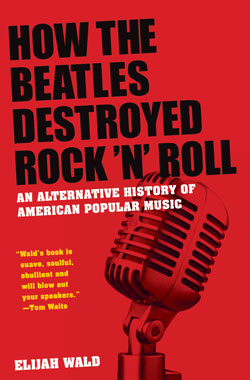 A
history of American pop music from the dawn of recording through the
1960s, which turns up new stories and provides a fresh outlook on old
ones by looking at what people were listening to and dancing to over
the years, rather than focusing on the usual histories of jazz and rock.
(Oxford
University Press)
A
history of American pop music from the dawn of recording through the
1960s, which turns up new stories and provides a fresh outlook on old
ones by looking at what people were listening to and dancing to over
the years, rather than focusing on the usual histories of jazz and rock.
(Oxford
University Press)
To buy online, I recommend Indiebound.org or Bookshop.org.
Reviews/Interviews/Radio shows
Errata:
corrections and emmendations.
Related article by Elijah on the evolution from live to recorded music,
from the British Financial
Times
"the most accurate and least spun history of American popular music I've ever read."
--Peter Keepnews
"I couldn't put it down. It nailed me to the wall, not bad for a grand
sweeping in-depth exploration of American music with not one mention
of myself. Wald's book is suave, soulful, ebullient and will blow out
your speakers."
--Tom Waits
"Wald explores... 80 years of popular music, from the earliest
days of recorded sound, deftly navigating the evolving complexities
of American race relations and the social and economic upheavals of
the last century. It's a tour de force."
--Jon Dennis, The Guardian
(UK)
"As an alternative, corrective history of American music ... Wald's
book is invaluable. It forces us to see that only by studying the good
with the bad—and by seeing that the good and bad can't be pulled
apart—can we truly grasp the greatness of our cultural legacy."
--Malcolm Jones, Newsweek
"the most challenging, and head-clearing history of American popular
music to be published in decades."
--Jeff Simon, The Buffalo
News (Editor's Choice)
"A bracing, inclusive look at the dramatic transformation in
the way music was produced and listened to during the 20th century....
One of those rare books that aims to upend received wisdom and actually
succeeds."
--Kirkus Reviews
"If you're looking, as Wald's subtitle has it, for 'an alternative
history of American music'...you've found it.... Wald is a meticulous
researcher, a graceful writer and a committed contrarian...an impressive
accomplishment."
--Peter Keepnews, The New
York Times Book Review
"Some of the smartest historiography I've ever read. The examples and
turns of phrase sometimes make me laugh out loud, and nearly every page
overturns another out-moded assumption. Elijah Wald just calls it like
he sees it and transforms everything as a result."
--Susan McClary, MacArthur
Fellow and author of Conventional
Wisdom: The Content of Musical Form and
Feminine Endings: Music, Gender, and Sexuality.
Clickbait title aside, How the Beatles Destroyed Rock ’n’ Roll is a history of American popular music stripped of the familiar clichés of jazz and rock history. Tracing the evolution of popular music through developing tastes, trends and technologies, rather than applying modern standards and genre categories, it gives a fuller, more balanced look at the broad variety of styles that captured listeners over the course of the twentieth century.
Wald goes back to original sources—recordings, period articles, memoirs and interviews—in an attempt to understand how music was heard and experienced over the years. He pays particular attention to the world of working musicians and ordinary listeners rather than to stars and specialists, looking at the evolution of jazz as dance music and of rock 'n' roll in terms of the teenage girls who made up the bulk of its early audience. There are plenty of famous names—Duke Ellington, Benny Goodman, Frank Sinatra, Elvis Presley, the Beatles—but they are placed alongside figures like Paul Whiteman, Guy Lombardo, Mitch Miller, Jo Stafford, Ricky Nelson and the Shirelles, who in some cases were far more popular and more accurately represent the mainstream of their times.
As the title suggests, this is not a hesitant or stolidly academic history, but neither is it heedlessly provocative. Wald’s intention was to explore the past with an open mind, asking some new questions and answering them as honestly and accurately as possible, and to make sense of times and people who often seem very foreign, though they are our own parents and grandparents. He has also tried to make that journey amusing and interesting, whatever we may think of ballroom orchestras, bobby-soxers, pop balladeers or British invaders.
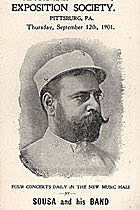 1. Amateurs and
Executants
1. Amateurs and
Executants
2. The Ragtime Life
The arrival of phonograph recording began an evolution from music made
by amateurs in their homes to music bought from professional
performers. John Philip Sousa led 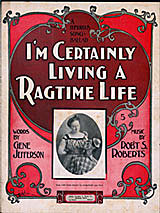 the country's most popular concert band, and helped make ragtime a national craze with pieces like "At a Georgia Camp Meeting," recorded in 1902. (Visit Internet Archive for a full Sousa program.) (Or watch Elijah Wald play a guitar arrangement of "At a Georgia Camp Meeting.")
the country's most popular concert band, and helped make ragtime a national craze with pieces like "At a Georgia Camp Meeting," recorded in 1902. (Visit Internet Archive for a full Sousa program.) (Or watch Elijah Wald play a guitar arrangement of "At a Georgia Camp Meeting.")
"When I played with the Tuxedo Brass Band I felt just as proud as though I had been hired by John Philip Sousa..."
-- Louis Armstrong
3. Everybody's Doin' It
In the teens, the U.S.was caught up
in the first big craze for social dancing. This chapter looks at the
arrival of the turkey trot, grizzly bear and, most famously, the fox
trot. We visit Irving Berlin, the singing waiter, the ballroom dance
masters Vernon and Irene Castle, and social reformers across the
country who feared that young women were on the road "From Dance Hall
to White Slavery."
4. Alexander’s Got a Jazz Band Now
5. Cake Eaters and Hooch Drinkers
Jazz arrived in the late teens, in rowdy performances like the Original Dixieland Jazz Band's "Livery Stable Blues," and was hailed as a new form of ragtime in songs like
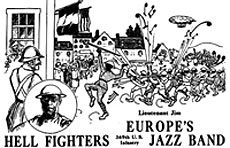 Marion
Harris's "When I Hear that Jazz Band Play." So what was jazz, at first? And what was the music of the "jazz age"
of the 1920s? We've all heard of bootleggers, speakeasies and flappers,
but how did Prohibition affect the music business? These chapters
attempt to sort out the realities behind some of America's most potent
cultural myths. (See Elijah Wald play "Sheik of Araby")
Marion
Harris's "When I Hear that Jazz Band Play." So what was jazz, at first? And what was the music of the "jazz age"
of the 1920s? We've all heard of bootleggers, speakeasies and flappers,
but how did Prohibition affect the music business? These chapters
attempt to sort out the realities behind some of America's most potent
cultural myths. (See Elijah Wald play "Sheik of Araby")
 6. The King of Jazz
6. The King of Jazz
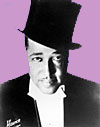
Paul Whiteman led the most popular and influential orchestra of the 1920s. Hiring some of the period's finest musicians and arrangers, who mixed classical techniques with jazz rhythms and melodies, he started out making huge hits like 1920's "Whispering," then created the decade's equivalent of Sgt Pepper when he comissioned George Gershwin to write A Rhapsody in Blue (this is the original 1924 version with Gershwin on piano). In the phrase of the time, he "made a lady out of jazz," changing it from a music of small, hot improvising bands into a style arranged for formal dance orchestras and concert presentations.
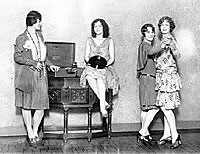 7. The Record, the Song and the Radio
7. The Record, the Song and the Radio
Records were growing in popularity throughout the teens and early twenties, but songs rather than specific recordings remained the basic currency of popular music. The arrival of radio, followed by the crash of the stock market, further altered the balance, providing a national entertainment medium that arrived for free over the airwaves. Live bands were no longer needed for every party, but could be heard for thousands of miles thanks to remote broadcasts. Listen to episodes of the Brunswick Brevities and the A&P Gypsies from 1929.
 8. Sons of Whiteman
8. Sons of Whiteman
9. Swing that Music
Whiteman's success helped to spawn a wave of large-scale dance orchestras, from the "sweet bands" of Guy Lombardo and Leo Reisman to African-American trendsetters like Fletcher Henderson and Ellington. By the mid-1930s, Benny Goodman helped push this style in the Henderson direction, and Tommy Dorsey and Glenn Miller blended this hotter style with the mellow orchestrations of the sweet bands for the classic big band sound. (Check out live Goodman and Dorsey broadcasts from the 1930s, and more swing and dance band recordings at jazz-on-line.com.)
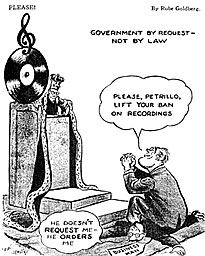 10. Technology and Its Discontents
10. Technology and Its Discontents
By the early 1940s, jukeboxes were replacing live performers in clubs,
records were replacing them on radio, and a lot of musicians were wondering how they were going to make a living. A ban on radio play of songs registered with the Association of Songwriters, Composers, and Publishers (ASCAP) encouraged a new wave of songwriters to sign with a rival group, Broadcast Music Incorporated (BMI) That dispute was followed by the American Federation of Musicians' recording ban, which prevented any American musicians from recording
for over a year, and that combination played a vital role in decentralizing the music
business. (Researchers might be interested in my timeline of
music-related labor disputes.)
11. Walking Floors and Jumpin’ Jive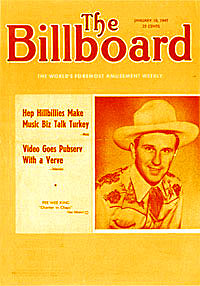
Thanks to jukeboxes, amplification and the mass population
shifts of World War II, the big bands began to face competition from
styles of music that urban marketers had thought would only attract
ethnic or fringe audiences. "Hep Hillbillies Make Music Biz Talk
Turkey," read the Billboard headline, next to a picture of
Pee Wee King, a Polish accordionist from Milwaukee.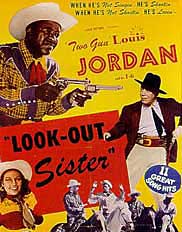 That blend of
hep, cowboy and immigrant appeals was picked up by everyone from the
Texan singer Al Dexter (who had a huge hit with the accordion and trumpet-backed "Pistol
Packin' Mama") to Bing Crosby (who waxed a honky-tonk "Walking the Floor Over You" with his brother Bob's orchestra), "Two Gun" Louis Jordan (who can be seen doing a cowboy-suited proto-rap, "Look Out!"), and the ever-perky Andrews Sisters (who slap each other five as they sing "Gimme Some Skin").
That blend of
hep, cowboy and immigrant appeals was picked up by everyone from the
Texan singer Al Dexter (who had a huge hit with the accordion and trumpet-backed "Pistol
Packin' Mama") to Bing Crosby (who waxed a honky-tonk "Walking the Floor Over You" with his brother Bob's orchestra), "Two Gun" Louis Jordan (who can be seen doing a cowboy-suited proto-rap, "Look Out!"), and the ever-perky Andrews Sisters (who slap each other five as they sing "Gimme Some Skin").
12. Selling the American Ballad
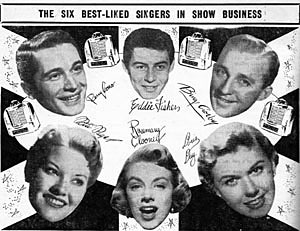 Both jazz and rock historians have tended to
treat the pop scene between the end of the big band era and the arrival
of rock 'n' roll as a musical wasteland, but to a great extent this was
the era that shaped the modern pop record and recording star. Mitch
Miller led a trend of studio-oriented producers who matched singers
with songs and instrumentation the way Hollywood producers cast movies.
And the music was a much more interesting mix than is usually
acknowledged--for instance, Miller's combination of Hank Williams's
songwriting with big band singers Jo Stafford and Frankie Laine
and the outer-space steel guitar of Speedy West on "Tonight We're Setting the Woods
on Fire".
Both jazz and rock historians have tended to
treat the pop scene between the end of the big band era and the arrival
of rock 'n' roll as a musical wasteland, but to a great extent this was
the era that shaped the modern pop record and recording star. Mitch
Miller led a trend of studio-oriented producers who matched singers
with songs and instrumentation the way Hollywood producers cast movies.
And the music was a much more interesting mix than is usually
acknowledged--for instance, Miller's combination of Hank Williams's
songwriting with big band singers Jo Stafford and Frankie Laine
and the outer-space steel guitar of Speedy West on "Tonight We're Setting the Woods
on Fire".
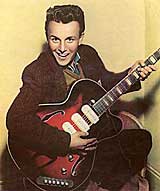 13. Rock the Joint
13. Rock the Joint
As television took over from radio as America's national broadcast medium, local stations began producing more of their own programs, relying more on records and targeting audiences television wasn't serving. Rhythm and blues shows attracted not only the African American audiences that were their principle market, but also white teenagers like Philadelphia's Charlie Gracie (in photo at right), who was inspired by seeing a local country band led by Bill Haley, made his debut on Paul Whiteman's TV Teen Club, then became one of the early rock 'n' roll hitmakers.Check out Gracie on the Ed Sullivan show, and Haley getting the hepcats on the floor and baffling the music business honchos with "See You Later, Alligator."
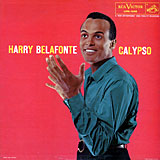 14. Big Records for Adults
14. Big Records for Adults
The 1950s are often described as the decade when
teenagers took over popular music, but in economic terms the big news
was albums overtaking singles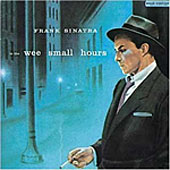 --which to a great extent meant the
triumph of music targeted at adults. Broadway cast albums, mood music,
the jazz of Dave Brubeck, the classical stylings of Van Cliburn, and
two dedicated masters of two very different kinds of song: Harry
Belafonte and Frank Sinatra. (See Belafonte's early performance of Jamaica Farewell, and Sinatra trading eights with Peggy Lee on "Nice Work if You Can Get It.")
--which to a great extent meant the
triumph of music targeted at adults. Broadway cast albums, mood music,
the jazz of Dave Brubeck, the classical stylings of Van Cliburn, and
two dedicated masters of two very different kinds of song: Harry
Belafonte and Frank Sinatra. (See Belafonte's early performance of Jamaica Farewell, and Sinatra trading eights with Peggy Lee on "Nice Work if You Can Get It.")
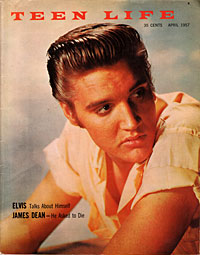 15. Teen Idyll
15. Teen Idyll
Television created a new kind of pop star--someone who rather than
being a faraway, super-talented figure was a regular teenager. Ricky
Nelson grew up in America's living rooms, and 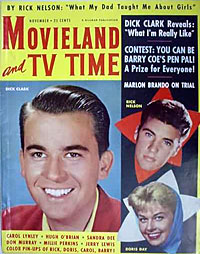 when he picked
up a guitar he instantly became the biggest rock 'n' roll star aside
from--of course--Elvis, with performances like 1959's "It's Late." Dick Clark's American Bandstand
created stars as quickly as it created dance steps, including a trumpet
prodigy named Frankie Avalon who was reborn as an slim Elvis clone
singing "Teacher's Pet" in Jamboree,
a film Clark co-produced.
when he picked
up a guitar he instantly became the biggest rock 'n' roll star aside
from--of course--Elvis, with performances like 1959's "It's Late." Dick Clark's American Bandstand
created stars as quickly as it created dance steps, including a trumpet
prodigy named Frankie Avalon who was reborn as an slim Elvis clone
singing "Teacher's Pet" in Jamboree,
a film Clark co-produced.
16. Twisting Girls Change the World
In the early 1960s, a wave of non-touch dances led by the twist 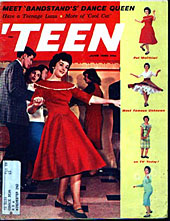 changed American
dancing forever--and gave gospel and Latin rhythms a new prominence on
the pop charts with bands like Joey Dee's racially mixed Starliters
drawing dancers of all ages to their shows at the Peppermint Lounge, and Chubby Checker
and Dee Dee Sharp demonstrating how to groove with gospel harmonies in
their duet of "Slow Twistin'." Girl
groups like the Shirelles brought female singers to the forefront with
songs ranging from the Crystals' ebullient "Da Doo Ron Ron" to Lesley Gore's explicitly
feminist "You Don't Own Me."
changed American
dancing forever--and gave gospel and Latin rhythms a new prominence on
the pop charts with bands like Joey Dee's racially mixed Starliters
drawing dancers of all ages to their shows at the Peppermint Lounge, and Chubby Checker
and Dee Dee Sharp demonstrating how to groove with gospel harmonies in
their duet of "Slow Twistin'." Girl
groups like the Shirelles brought female singers to the forefront with
songs ranging from the Crystals' ebullient "Da Doo Ron Ron" to Lesley Gore's explicitly
feminist "You Don't Own Me."
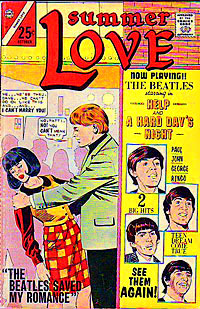
17. Say You Want a Revolution…
The British Invasion that began with the Beatles' record-setting American debut on the Ed Sullivan Show not only transformed rock 'n' roll but in some ways marked the end of pop music as it had existed for the previous seventy years. Bands now were going on the road to advertise their recordings, rather than vice-versa, and soon the Beatles would be making music that they couldn't perform live, even if they wanted to. Meanwhile, the pop scene was bifurcating--rock was increasingly meant for listening rather than dancing, and Black and white styles were diverging. For a taste of how things sounded in mid-invasion, check out an hour of Top 40 radio from Scottsdale Arizona in the summer of 1964, complete with an interview with the leader of the Beatle Boosters Fan Club as they circulate their petition to bring the Beatles to Arizona. (There is a lot more amazing radio from this period at the reelradio archive.)
New
York Times Book Review review
Jazz Research Journal review
Newsweek review
Guardian
UK review
The
Onion AV Club review
Boston
Globe review
Toronto
Globe and Mail review
Buffalo
News review
Chicago
Reader review
Philadelphia
City Paper review
Winston-Salem Journal review
Library
Journal review
Brooklyn Rail review
Interview
for the Boston Herald
Jakarta
Globe review
ExpressMilwaukee.com
review
Memphis Flyer review
Guest
deejaying KPFK's Global Village
with Betto Arcos
Podcast
interview for Book Soup in Los Angeles (for those unused to podcasts,
you click the little orange square thing)
Interview
on WNYC's Soundcheck
and...
Interview for El Estado de Sao Paolo:
print
(in Portuguese) video
(English, with Portuguese subtitles)
Review in Dutch from the Amsterdam Volkskrant.
Review from the Polish edition of Newsweek:
"Czy
The Beatles zabili rocka?"